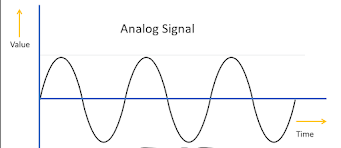Data communication Terminology
Data communication refers to the transmission of data or information between two or more devices using a communication channel. Here are some terms commonly used in data communication:
a. Data
Data is information or facts that can be processed by a computer or other device. It can be in the form of text, numbers, images, audio, or video, and it is often stored in a structured format such as a database or spreadsheet.
Data is often used to represent and describe the real world, and it can be analyzed and used to make decisions or draw conclusions.
Data can be collected through various means, such as observation, experiments, or surveys. It is an important resource for businesses, organizations, and individuals, as it can be used to inform decision-making, drive innovation, and support research and development.
b. Data Transmission
Data transmission refers to the transfer of data from one device to another over a communication channel.
or
Data transmission means sending and receiving data through transmission medium.
The transmission mediums include cables (e.g. telephone lines or fiber optics) or
wireless medium like microwave, infrared and satellite, etc. The data can be
transmitted from one place to another in the form of electromagnetic or light waves
through communication "medium. The electromagnetic or light waves representing
data are called signals. Data communication signals can be in analog or digital term.
C. Analog Signals
An analog signal is a continuous signal that can take on an infinite number of values within a given range. Analog signals are commonly used to transmit information such as sound or video, as they can accurately reproduce the continuous and varying nature of these types of data.
An analog signal is typically generated by a device such as a microphone or a camera, and is then converted into a series of electrical pulses for transmission over a communication channel. The signal can be transmitted over a variety of mediums, including copper wire, optical fiber, or wireless channels.
At the receiver, the analog signal is converted back into its original form, such as an audio or video signal. This process is done using an analog-to-digital converter (ADC), which samples the analog signal at regular intervals and converts the samples into digital values.
Analog signals are prone to degradation over long distances or through noisy channels, as any distortions in the signal can accumulate and affect the accuracy of the reproduction. Digital signals, on the other hand, can be transmitted with less degradation, as they can be encoded and transmitted in a way that is more resistant to noise and errors.
Fig 4.1a Analog Signal
d. Digital Signals
Digital signals are discrete signals that can take on only a finite number of values. They are commonly used in computing and digital communication systems to transmit data.
A digital signal is typically generated by a device such as a computer or a sensor, and is then converted into a series of electrical pulses or electromagnetic waves for transmission over a communication channel. The signal can be transmitted over a variety of mediums, including copper wire, optical fiber, or wireless channels.
At the receiver, the digital signal is typically converted back into its original form using a digital-to-analog converter (DAC). This process involves converting the digital values back into analog electrical pulses or waves, which can then be used to reproduce the original data, such as an audio or video signal.
Digital signals are generally more reliable and efficient than analog signals, as they are less prone to degradation and noise. Digital signals can also be easily transmitted over long distances without significant loss of quality, as errors can be detected and corrected using error detection and correction techniques.
A digital signal is shown in Figure 4.1b.
Fig 4.1b Digital Signal






0 Comments